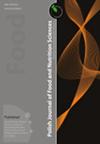行为改变沟通倡议对肯尼亚维希加县6-59个月儿童护理人员维生素A补充知识的有效性
IF 2.3
4区 农林科学
Q3 FOOD SCIENCE & TECHNOLOGY
引用次数: 0
摘要
维生素A补充(VAS)是世界卫生组织推荐的一种低成本、高影响、可接受和临床有效的干预措施,用于对抗6-59个月儿童普遍缺乏维生素A的影响,这仍然是全球关注的公共卫生问题。因此,这一年龄组保持良好健康和预防疾病需要摄入足够的维生素a。遗憾的是,多年来VAS覆盖率一直很低,全球64个重点国家的平均覆盖率为61%,东部和南部非洲的覆盖率为57%,肯尼亚为67.3%,远低于世卫组织80%的目标。与低VAS摄取相关的关键障碍之一是知识不足。本研究旨在测试基于社区的干预措施在肯尼亚Vihiga县扩大6至59个月儿童VAS吸收方面的有效性。采用准实验的前后设计,分为两组,干预组和对照组。总共在基线和终点分别招募了393名和389名6-59个月儿童的照顾者。采取的干预措施包括使用研究期间制定的指南,开发和传播针对6-59个月儿童照顾者的VAS行为改变交流材料。使用逻辑回归模型,并采用差异中差异分析来检测两组之间的变化。由于干预,护理人员的VAS知识显著增加了18.4% (p= <0.001)。与这种增加相关的关键显著因素是护理人员拥有MCH手册(OR=2.21, 95% CI: 1.31-3.74;p=0.003),从设施卫生工作者那里获得VAS信息(OR=1.73, 95% CI: 1.01, 2.97;p=0.047),从社区卫生志愿者那里接收信息(OR=2.35, 95% CI: 1.50, 3.66;p<0.001)和中等教育程度(OR =3.36, 95% CI: 1.27-8.94;p = 0.015。本研究的结论是,该干预有效地提高了6至59个月儿童的护理人员对VAS的了解。本文章由计算机程序翻译,如有差异,请以英文原文为准。
Effectiveness of Behaviour Change Communication Initiatives on Vitamin A Supplementation Knowledge Among Caregivers of Children Aged 6-59 Months in Vihiga County, Kenya
: Vitamin A Supplementation (VAS) is a low-cost high impact, acceptable, and clinically effective intervention recommended by the World Health Organization to combat the effects of the prevalent Vitamin A deficiency in children 6-59 months which remains a public health concern globally. Maintenance of good health and prevention of diseases in this age group therefore requires adequate intake of Vitamin A. Sadly, VAS coverage has remained low over the years, averaging 61% across 64 priority countries globally and Eastern and Southern Africa recording a coverage of 57%, Kenya 67.3% which is way below the WHO target of 80%. One of the key barriers associated with low VAS uptake is inadequate knowledge. This study was conducted to test the effectiveness of community-based intervention in scaling up VAS uptake for children aged six to fifty-nine months in Vihiga County, Kenya. A quasi-experimental pre-post design was employed with two arms, intervention, and control. In total, 393 and 389 caregivers of children 6-59 months were recruited at baseline and endline respectively at both arms. The intervention undertaken included development and dissemination of VAS behaviour change communication materials targeting caregivers of children 6-59 months using guides developed during the study. Logistic regression models were used, and Difference-In-Difference analysis applied to detect changes between the two arms. Due to the intervention, VAS knowledge by caregivers significantly increased by 18.4% (p= <0.001). Key significant factors associated with this increase were caregivers having MCH Handbook (OR=2.21, 95% CI: 1.31-3.74; p=0.003), receiving information on VAS from health worker at facility (OR=1.73, 95% CI: 1.01, 2.97; p=0.047), receiving information from community health volunteers (OR=2.35, 95% CI: 1.50, 3.66; p<0.001) and having secondary education (OR =3.36, 95% CI: 1.27-8.94; p=0.015. This study concludes that this intervention was effective in increasing the VAS knowledge among the caregivers of children aged six to 59 months.
求助全文
通过发布文献求助,成功后即可免费获取论文全文。
去求助
来源期刊

Polish Journal of Food and Nutrition Sciences
FOOD SCIENCE & TECHNOLOGY-
CiteScore
4.30
自引率
12.50%
发文量
25
审稿时长
20 weeks
期刊介绍:
The Polish Journal of Food and Nutrition Sciences publishes original, basic and applied papers, reviews and short communications on fundamental and applied food research in the following Sections:
-Food Technology:
Innovative technology of food development including biotechnological and microbiological aspects
Effects of processing on food composition and nutritional value
-Food Chemistry:
Bioactive constituents of foods
Chemistry relating to major and minor components of food
Analytical methods
-Food Quality and Functionality:
Sensory methodologies
Functional properties of food
Food physics
Quality, storage and safety of food
-Nutritional Research Section:
Nutritional studies relating to major and minor components of food (excluding works related to questionnaire
surveys)
-“News” section:
Announcements of congresses
Miscellanea
 求助内容:
求助内容: 应助结果提醒方式:
应助结果提醒方式:


